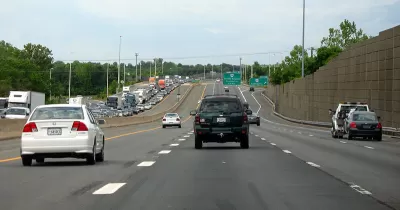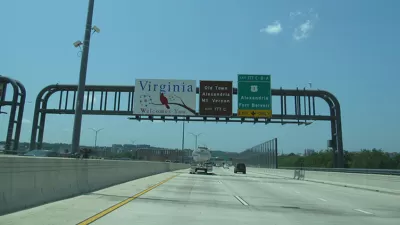The current plan for the widening of I-66 in Virginia would place a bike lane between vehicle traffic and a sound wall.

Canaan Merchant critiques plans "to widen I-66 include building a new bike trail that runs from where the Custis Trail ends in Arlington all the way out to Centreville."
The bike lane would be added to the Outside the Beltway Project—the proposal to widen I-66 that David Alpert critiqued in April 2012. The public-private partnership between the Virginia Department of Transportation (VDOT) and the Department of Rail and Public Transportation (DRPT), and private partner, I-66 Express Mobility Partners, will expand I-66 to ten lanes between Haymarket and Falls Church.
According to Merchant, "one positive aspect is that the project will include a new trail that extends from the Custis Trail, which runs parallel to I-66 in Arlington, from its western end to Centreville (it'd go there at first, but then even farther). The 22-mile extension would make the Custis one of the longest trails in the region, giving a lot of local neighborhoods a new option for biking and walking."
Merchant's argument, however, is that for all the benefits of gaining a new bike trail, this one could be a lot better:
As it is currently planned, the new trail would put trail users in a squeeze, literally. Plans show it running along the highway side of the sound barrier, the big wall that separates 66 from where people live. That means trail users would be closer to high-speed traffic and farther from the neighborhood connections, which likely means far fewer people would be willing to get out and use it.
To help conjure an idea about what the experience of this trail would be like, the Fairfax Alliance for Better Bicycling created the following visualization.
Merchant has a better idea: "move the trail to the opposite side of the sound wall, and make it at least 12 feet wide."
FULL STORY: A new bike trail will basically run along the shoulder of I-66

Planetizen Federal Action Tracker
A weekly monitor of how Trump’s orders and actions are impacting planners and planning in America.

DARTSpace Platform Streamlines Dallas TOD Application Process
The Dallas transit agency hopes a shorter permitting timeline will boost transit-oriented development around rail stations.

Congressman Proposes Bill to Rename DC Metro “Trump Train”
The Make Autorail Great Again Act would withhold federal funding to the system until the Washington Metropolitan Area Transit Authority (WMATA), rebrands as the Washington Metropolitan Authority for Greater Access (WMAGA).

Supreme Court Ruling in Pipeline Case Guts Federal Environmental Law
The decision limits the scope of a federal law that mandates extensive environmental impact reviews of energy, infrastructure, and transportation projects.

Texas State Bills to Defund Dallas Transit Die
DART would have seen a 30% service cut, $230M annual losses had the bills survived.

Bikeshare for the Win: Team Pedals to London Cricket Match, Beats Rivals Stuck in Traffic
While their opponents sat in gridlock, England's national cricket team hopped Lime bikes, riding to a 3-0 victory.
Urban Design for Planners 1: Software Tools
This six-course series explores essential urban design concepts using open source software and equips planners with the tools they need to participate fully in the urban design process.
Planning for Universal Design
Learn the tools for implementing Universal Design in planning regulations.
Roanoke Valley-Alleghany Regional Commission
City of Mt Shasta
City of Camden Redevelopment Agency
City of Astoria
Transportation Research & Education Center (TREC) at Portland State University
US High Speed Rail Association
City of Camden Redevelopment Agency
Municipality of Princeton (NJ)




























